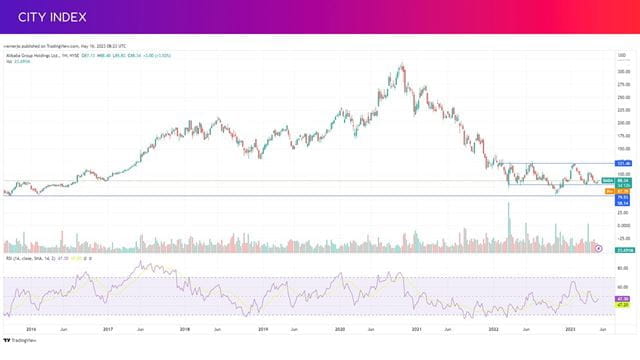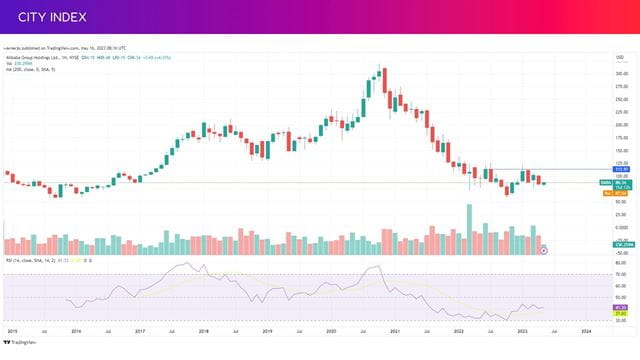
Key takeaways
- Alibaba expected to report improvement in sales and earnings
- Heightened focus on individual business units as they prepare to spin-off, pursue their own IPOs and raise fresh cash
- Alibaba likely to prioritise profitability to boost valuations
- Sharper focus on costs, reopening of Chinese economy and new AI prospects could provide catalysts for new financial year
- Alibaba shares continue to trade below pre-pandemic levels and remain unloved by the markets
When will Alibaba release earnings?
Alibaba will release results for the year to the end of March 2023 before US markets open on Thursday May 18. A conference call is scheduled on the same day at 0730 ET (1930 HK).
Alibaba earnings consensus
Alibaba is expected to report a 2.5% year-on-year rise in revenue in the fourth quarter to RMB209,189 million and an 18.8% rise in adjusted EPS to RMB9.45.
If it meets expectations in the period, then Alibaba is on course to report a 2.1% rise in annual revenue to RMB870,889 million and a 0.9% rise in full year adjusted EPS to RMB53.18.
Alibaba earnings preview
Alibaba announced earlier this year that it plans to break itself up into six separate businesses, most of which will be spun-off through their own initial public offerings, in the hope each division will have more success raising their own capital and earning their own valuations. That will heighten the focus on each individual part of Alibaba, which will be left with stakes in the spin-offs and focused on its core Taobao Tmall commerce platform.
With this in mind, Wall Street is anticipating that all of its divisions will report revenue growth in the final quarter, apart from a mild dip from its media and entertainment arm. Below is an outline of consensus expectations for the fourth quarter and full year for each division:
|
Division (RMB, in billions) |
Q4 2023E |
YoY Change |
FY 2023E |
YoY Change |
|
China Commerce |
142.2 |
1.4% |
584.2 |
-1.4% |
|
International Commerce |
16.9 |
18.2% |
67.1 |
9.8% |
|
Local Consumer Services |
12.1 |
15.4% |
48.7 |
11.9% |
|
Cainiao Logistics |
14 |
21.1% |
55.6 |
20.5% |
|
Cloud Computing |
20.3 |
7.0% |
78.4 |
5.1% |
|
Digital Media & Entertainment |
8 |
-0.5% |
31.2 |
-3.3% |
|
Total |
209.2 |
2.5% |
870.9 |
2.1% |
(Source: Bloomberg consensus)
Alibaba is likely to prioritise profitability across its businesses to ensure they are as attractive as possible ahead of any listings, especially as markets are more focused on businesses that can deliver earnings during tougher conditions and amid the uncertain economic outlook rather than growth. This could also prove critical in deciding the speed at which each individual unit, which now has its own independent CEO that have greater responsibility for their business, can pursue an IPO.
Its adjusted Ebita margin is expected to come in at 14.2% in the fourth quarter, lower compared to the previous three quarters but up from the 11% margin seen the year before. That is forecast to see adjusted Ebita jump 55.6% to RMB24,609 million.
The focus could fall on its activities that are still in the red. Currently, all of Alibaba’s earnings come from its core commerce operation in China and its cloud computing arm. The rest of Alibaba’s business continue to produce losses, especially its international commerce arm and local consumer services in China. Interestingly, some media reports have suggested Cainiao and its international commerce arm, which homes Lazada and AliExpress, are the first units racing to be formally spun-off, suggesting these could be under pressure to make the biggest improvement in profitability. The first IPO will be key as success could feed through to any subsequent listings, in the same way that a poor spin-off could sour the mood about the valuations its other units can secure.
Signs that these losses are narrowing would therefore be welcomed and install more confidence in Alibaba’s separation plans, especially as this will play a significant role in deciding the value of each business. The key goal of the spinoffs is to unlock value, but that may be harder if the businesses being separated are in the red and reliant on growth prospects to drive their valuation.
Alibaba has sharpened its focus on costs, including reducing losses from overseas commerce and improving efficiency from its core operations, and is positioned well to benefit from any recovery as the Chinese economy reopens. The country has abandoned its fight against Covid-19, although this is not expected to be fully reflected in the fourth quarter earnings and should provide a more noticeable catalyst in the new financial year.
Investors will also be on the lookout for updates on new catalysts after Alibaba launched its own AI-driven chatbot named Tongyi Qianwen. Still, the company has said it is not interested in having an AI chatbot for the sake of it and has made it clear that its priority is integrating the technology into its existing products to improve them. It has already been added to its workplace messaging app DingTalk and is being included in its voice assistant Tmall Genie. Plus, Alibaba is hoping the explosion in interest in generative AI and large language models will provide a much-needed boost to its cloud computing division on expectations that there will be ‘exponential growth in demand for compute power’ as companies look to train their AI models with large swathes of data.
Where next for BABA stock?
Alibaba’s ADRs are down 4% since the start of 2023 and the stock remains a staggering 59% below where it traded before the pandemic started in 2020, despite the fact China has put Covid-19 and its regulatory crackdown on tech companies behind it. This is one of the reasons why Alibaba is looking to break itself up in the hope of regaining some of this lost value.
Notably, Alibaba currently trades at a blended-forward price to earnings ratio of just 10.2x, according to data from Bloomberg, which is less than half the industry average of 22.5x. Rivals like JD.com (12.2x) and Pinduoduo (16.0x) trade at higher multiples.
Turning to the weekly chart, we can see Alibaba shares have been rangebound over the past 18 months, trading between highs of $121 and lows of $58, in-line with all-time lows – although we have seen signs of support emerging at $80 this year.

The monthly chart shows that Alibaba shares have tried and failed to close the month above $113.70 on numerous occasions since June 2022, making this another upside target to keep an eye on going forward.

Take advantage of extended hours trading
Alibaba will release earnings before US markets open and most traders must wait until the opening bell before being able to trade. But by then, the news has already been digested and the instant reaction in share price has happened in after-hours trading. To react immediately, traders should take their positions in pre-and post-market sessions.
With this in mind, you can take advantage of our service that allows you to trade Apple and other tech stocks using our extended hours offering.
While trading before and after hours creates opportunities for traders, it also creates risk, particularly due to the lower liquidity levels. Find out more about Extended Hours Trading.
How to trade Alibaba stock
You can trade Alibaba shares with City Index in just four easy steps:
- Open a City Index account, or log-in if you’re already a customer.
- Search for ‘Alibaba’ in our award-winning platform
- Choose your position and size, and your stop and limit levels
- Place the trade
Or you can practice trading risk-free by signing up for our Demo Trading Account.










